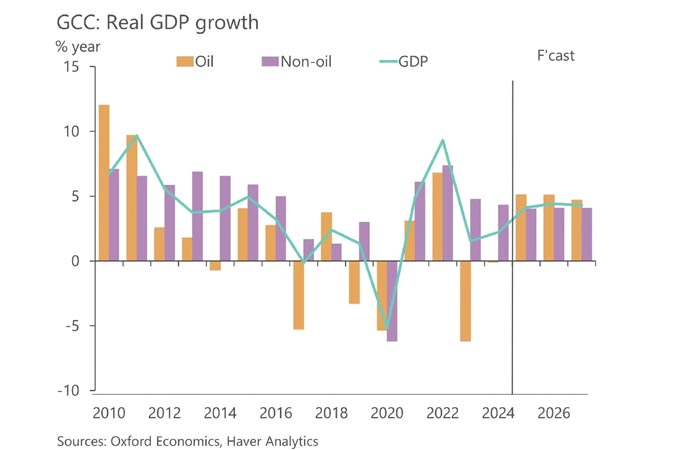
Saudi Arabia and the UAE are poised to lead the Gulf’s economic expansion in 2026, supported by strong private-sector performance, resilient domestic demand and renewed investment momentum, according to a new report.
The latest ICAEW Economic Insight Q4 2025 report, produced by Oxford Economics, says the GCC is expected to outperform most global regions next year, with regional GDP forecast to grow by 4.4%.
Across the GCC, non-energy activity is projected to expand by 4.1% in 2026, driven by strong labour markets, improving credit conditions and rising investment in technology and AI-related infrastructure. Consumer spending remains a key engine of growth, expected to increase by an average of 3.5% over 2026–2027. Although oil revenues will be under pressure in the first half of 2026, production is expected to rise again in the second half of 2026, supporting the region’s medium-term outlook, the report says.
Saudi Arabia: non-oil strengthens
Saudi Arabia will remain a major contributor to GCC momentum, with GDP forecast to grow 4.3% in 2026. Non-oil activity continues to strengthen, with the October PMI exceeding 60 - one of the highest readings in over a decade, reflecting strong business confidence - and non-oil exports rising 17.1% year-to-date.
Growth will be supported by industrial expansion and policy reforms, including eased foreign ownership rules that aim to stimulate further investment. The fiscal deficit is projected to widen to 5.6% of GDP next year amid softer oil prices, while the recent five-year rent freeze in Riyadh aims to ease inflationary pressures, though it may constrain future housing supply. Despite these headwinds, sustained government spending on its development agenda under Vision 2030 is expected to support long-term diversification and economic resilience.
UAE: Strong domestic fundamentals
The UAE is also positioned for another strong year of performance, with GDP forecast to rise 5.6% in 2026 as non-oil sectors continue to expand. Tourism, trade and financial services remain key growth drivers, supported by population growth and sustained domestic demand. Dubai’s economy grew 4.4% in the first half of 2025, reflecting broad-based non-oil strength. A significant increase in the 2026 federal budget further reinforces long-term growth ambitions under the ‘We the UAE 2031’ strategy. Oil production is expected to pick up again in the second half of 2026, complementing ongoing investment in infrastructure, technology and international trade partnerships.
Hanadi Khalife, Head of Middle East, ICAEW, said: “This quarter’s outlook reinforces how far the GCC has come in building diverse, resilient and globally competitive economies. With Saudi Arabia and the UAE driving momentum through non-oil expansion, investment in technology, and long-term development planning, the region is well positioned to navigate global uncertainties and continue shaping its role as an economic leader. The progress we are seeing reflects an economic transformation that is strategic, sustained and delivering real impact.”
Scott Livermore, ICAEW Economic Advisor, and Chief Economist and Managing Director, Oxford Economics Middle East, said: “Saudi Arabia and the UAE are entering 2026 with strong foundations. Saudi non-oil activity is gaining pace, supported by robust demand and rising investment, even as fiscal pressures increase. The UAE continues to benefit from solid domestic fundamentals, a sharp uplift in government spending and sustained diversification efforts. While the OPEC+ pause will weigh on oil-sector growth early in the year, easing financial conditions and the region’s expanding non-oil economies should underpin another year of solid performance.” -TradeArabia News Service
Send us your company’s news today and they could be featured on ABC’s Community News tommorow.